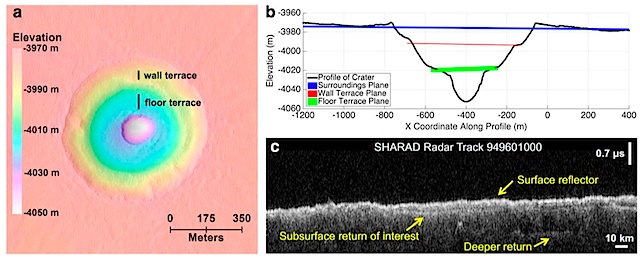 Just beneath the planet’s dirt surface, University of Arizona researchers found an enormous slab of water ice, measuring 130 feet thick and covering an area equivalent to that of California and Texas combined.
Just beneath the planet’s dirt surface, University of Arizona researchers found an enormous slab of water ice, measuring 130 feet thick and covering an area equivalent to that of California and Texas combined.
It was a “crazy-looking crater” on the face of Mars that caught Ali Bramson’s eye. But it was a simple calculation that explained the crater’s strange shape. Combining data gleaned from two powerful instruments aboard NASA’s Mars Reconnaissance Orbiter, or MRO, Bramson and her colleagues determined why the crater is terraced — not bowl shaped, like most craters of this size.
“Craters should be bowl shaped, but this one had terraces in the wall,” says Bramson, a graduate student in the University of Arizona’s Lunar and Planetary Laboratory, or LPL.
[The research was published online in the journal Geophysical Research Letters.]
“When the crater is forming, the shock wave from an object hitting a planet’s surface propagates differently depending on what substrates are beneath the area of impact,” Bramson says. “If you have a weaker material in one layer, the shock wave can push out that material more easily, and the result is terracing at the interface between the weaker and stronger materials.” [More at links]









